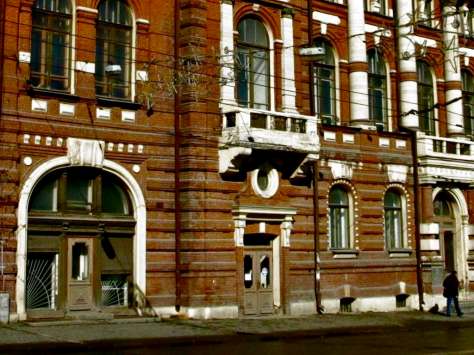You may not realize that Lidia Bazanova (1864-1916) is worthy of your attention. There isn’t a damn thing about her in the English-language internet, and she is not included in John Milner’s wonderful Dictionary of Russian and Soviet Artists: 1420-1970. But as it turns out, even Russia chose to forget her for quite awhile. Here is what a major reassessment of her life and work had to say on the website of the Tomsk Regional Museum of Art: “The artist herself and her work were long forgotten; her creative biography was never published. Tomsk residents recalled this interesting person and artist only in the 1990s when a few newspaper articles appeared.” I’m not the best person to crack the silence about her, because I virtually know nothing myself. But that doesn’t mean you can’t do a little hunting and reading and thinking, does it?
The building I show in this post is now called the Officer’s House (address: 50 Lenin Prospekt). When Bazanova lived in Tomsk it was called the Public Meeting building and it was here that Bazanova not only organized her own first personal exhibit of paintings, but the first large art exhibit ever held in this city. That took place in 1902. I don’t know this for a fact, but I’m guessing that one of the paintings included in that exhibit was her Portrait of a Young Girl, which was painted in 1901. Because you’ll have a heck of a time finding that painting on the net anywhere, I am breaking my own little “rule” of showing only architecture and monuments and inserting the painting below as the last image in this post. You can see another of Bazanova’s best known paintings, Portrait of Grigory Nikolaevich Potanin (1915), on the museum.ru website. Note that you can increase the size of this electronic reproduction by clicking on the + magnifying glass icon in the upper left corner. If you’re interested in more about Potanin and Tomsk, see the post I made on this blog-site in August.
Bazanova was born Lidia Pupareva in Sernovodsk in the Samara gubernia and she died in Kazan. She graduated from the Moscow Institute of Sculpture and Architecture in 1895, following her husband Ivan Bazanov to Tomsk in 1899 or 1900, depending upon the source. Ivan Bazanov was a professor of civil law and ship building (that’s what Russian Wikipedia tells us) until 1913. He was rector of the university from 1909-1913. The couple moved to Kazan in 1913. Bazanova not only painted, she was an instrumental figure in organizing art exhibits in Tomsk. She also was a well-regarded art critic and a teacher of art and painting. She stood behind the first Siberian Mobile Art Exhibit in 1903, an exhibit of French artists in Tomsk in 1904, and numerous exhibits of the Tomsk Society of Appreciators of Art from 1908 to 1909. She participated in an international exhibit of fine arts in Rome in 1911 and her paintings were exhibited in various Moscow shows. I have drawn much of this information from the internet Encyclopedia of Siberia.
As far as I can tell, the fullest treatment of Bazanova’s life and work to date is the first article I link to above on the site of the Tomsk Regional Museum of Art. In addition to detailed biographical and artistic information, it publishes short memoirs of the artist, as well as several newspaper reviews of her work. It also has a fairly large bibliography. (It is worth going to the article even if you don’t read Russian because there are several reproductions of her paintings there.) Here is one paragraph from this article:
“In March 1902 Lidia Pavlovna Bazanova appeared before the Tomsk public as an artist. In one of the rooms of the Public Meeting building the artist exhibited 47 or 49 (newspapers print various numbers) works, among which there were 11 large canvases. We do not have a complete list of the works that were shown; no catalogue of the exhibit has yet been found. It was the first major personal exhibit in the history of the city, and it presented an artist who commanded various genres with equal professionalism, who was capable of painting fresh, spontaneous studies and of creating large, accomplished compositions. It was precisely Bazanova who introduced Tomsk residents to serious painting on significant themes. She quickly won over the affection of colleagues and those journalists who wrote about artistic events in the life of the city. The opinion was shared by all: ‘Tomsk had never seen such an exhibit.'”





